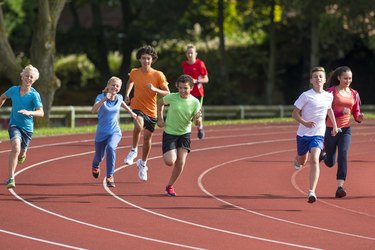
Exercise is vital for 13-year-old boys for both physical and mental development. It is important to encourage physical activity at this age because it can turn into a habit that will last a lifetime.
Sports can be a great way for a young teen to get enough physical exercise each day, as they are interactive, fun and social. Weight training routines for 13-year-old boys is another possibility, but certain restrictions must be taken into consideration so that it is safe for growing bodies.
Video of the Day
Video of the Day
Walk, Jog or Run
A 60-minute period of walking, jogging or running — seven days per week according to the Physical Activity Guidelines for Americans — should start with a warmup session of five to 10 minutes of marching in place with high knees before slowly increasing speed to a jog or running pace.
This can continue for 45 minutes, with short breaks if needed, and be followed by a cool-down with a five- to 10-minute walk. This can also be done in a sports setting, such as soccer practice, or can be broken up into shorter segments throughout the day.
Cycling as an Aerobic Activity
Bike riding is an activity that most teenagers enjoy, and it provides an excellent aerobic workout in addition to being a fun and recreational. After stretching the legs, arms and back muscles for five minutes, a slow ride for five to 10-minutes serves as a warmup of muscles and to build the heart rate.
After that, a moderate to vigorous pace for 30 to 45 minutes should be followed by a cool-down period of five to 10 minutes of slow biking or walking.
Gentle Plyometric Exercises
Teens should warm up for plyometric exercises by jogging for five to 10 minutes. Thirteen-year-olds should begin doing plyometrics for a short time period and gradually work their way to a longer routine. This should be done on two nonconsecutive days per week. A good beginner's routine would involve an upper-body exercise, such as chest passes or overhead passes with a medicine ball.
That might be followed by a lower-body exercise, such as double-leg jumps or box jumps. The routine may include six to 10 repetitions of one to three sets of each exercise per session. This should be followed by a five-minute cool-down walk or jog.
Yoga for Flexibility and Mindfulness
Yoga is a good exercise for 13-year-old boys because it helps them stay flexible, increases muscle and bone strength, and often raises levels of mindfulness in day-to-day life, says TeensHealth From Nemours. An example of a simple yoga routine begins with a Mountain pose, moves to the Tabletop pose, then on to Downward-Facing Dog.
Child's pose helps the boys rest for a moment before moving into Warrior Two pose. From there, they may move into Tree, Bridge and — finally — Corpse pose to relax for a few minutes before ending the session. Teens should be reminded to breathe during the poses.
Weight Training for Strength
Thirteen-year-old boys who have gone through puberty can safely engage in a strength-training routine utilizing their own body weight for resistance. This should be done three times per week for approximately 30 minutes per session. Teens should begin with a five to 10-minute warmup consisting of walking, jogging or another cardio activity at an easy pace.
Exercises in the strength-training session should include push-ups, pull-ups, sit-ups, bicycle crunches, step-ups, tricep dips, back extensions, lunges and squats. Boys should start by doing one set of 15 repetitions of each exercise and work their way to three sets of eight to 15 repetitions of each exercise.
An experienced fitness professional should supervise the exercises to ensure proper form until no longer necessary, insists Creighton University.
- John Hopkins University: "Obesity: Nutrition and Exercise"
- Net Wellness: "Dietary and Exercise Recommendations for Children and Adolescents for Healthy Living"
- Health.gov: “Physical Activity Guidelines for Americans, 2nd Edition: Chapter 3: Active Children and Adolescents”
- Creighton University: "Strength Training for Young Athletes"
- TeensHealth From Nemours: "Yoga"
- American College of Sports Medicine: "Plyometric Training for Children and Adolescents"